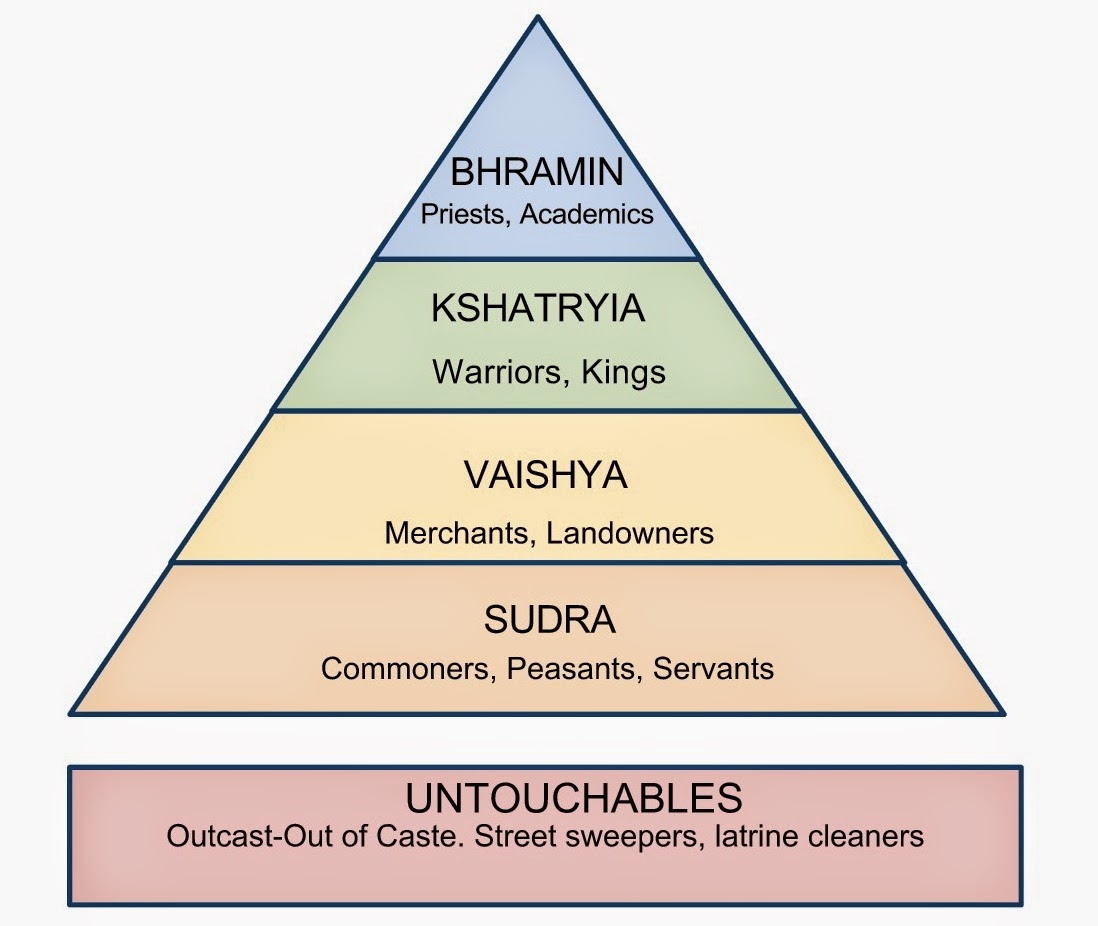Table of Contents
Caste System and Varna system
The caste system and varna system are two distinct but related social hierarchies that have been present in India for thousands of years. These systems are based on the principle of birth-based social status and have played a significant role in shaping the social, economic, and political landscape of India.
The Varna System
The varna system is an ancient social classification system that categorizes people into four distinct social classes or varnas based on their occupation. The four varnas are Brahmins (priests and scholars), Kshatriyas (warriors and rulers), Vaishyas (merchants and traders), and Shudras (artisans and laborers). Each varna was believed to have a specific role and function in society.
The varna system was originally based on the principle of meritocracy, with individuals being classified into a particular varna based on their aptitude and skill for a particular occupation. However, over time, the varna system became rigid and birth-based, with individuals being classified into a particular varna based on their family background.
The Caste System
The caste system is a more complex social hierarchy that evolved from the varna system. The caste system divides people into numerous castes or jatis, which are based on a person’s birth, family background, and occupation. The caste system is hierarchical, with each caste being considered superior or inferior to others.
The caste system has been deeply entrenched in Indian society for centuries, and caste identity has played a significant role in shaping social and economic interactions. Castes are endogamous, meaning that members are expected to marry within their own caste. Caste discrimination and untouchability have been significant problems in India, with Dalits, or those considered to be of lower castes, being subjected to discrimination and social exclusion.
The Impact of Caste and Varna System
The caste and varna systems have had a significant impact on Indian society, shaping social and economic interactions and reinforcing social hierarchies. While the varna system was originally based on meritocracy, it eventually became birth-based and entrenched social and economic inequalities. The caste system further reinforced these inequalities, with lower castes being subjected to discrimination and social exclusion.
In recent years, there have been efforts to reform the caste and varna systems and reduce caste discrimination in India. These efforts have included affirmative action policies to provide greater opportunities to those from lower castes and educational campaigns to promote awareness of caste discrimination and its impact on society.
Caste System and Varna system: Conclusion
The caste and varna systems are complex social hierarchies that have played a significant role in shaping Indian society for centuries. While the varna system was originally based on meritocracy, it eventually became birth-based and entrenched social and economic inequalities. The caste system further reinforced these inequalities, with lower castes being subjected to discrimination and social exclusion. Efforts to reform these systems and reduce caste discrimination are ongoing and will continue to shape Indian society in the years to come.
Caste System in India
Caste system is a hierarchical social structure that has been prevalent in India for centuries. It is based on the principle of division of labor, where individuals are categorized into different social groups or castes based on their occupation and birth. The caste system has been a controversial topic in India, with debates and discussions revolving around it for decades. While some argue that it is a crucial part of India’s social fabric, others argue that it is a regressive and discriminatory system that needs to be eradicated.
- The caste system in India is said to have originated from the Vedic period, where the society was divided into four main categories, namely Brahmins (priests and scholars), Kshatriyas (warriors and rulers), Vaishyas (merchants and traders) and Shudras (laborers and artisans).
- These categories were further subdivided into various sub-castes based on occupation, birth, and social status.
- One of the most significant drawbacks of the caste system is the practice of untouchability, where people belonging to the lowest caste, also known as the Dalits, are considered impure and are discriminated against in various aspects of life.
- This discrimination takes various forms, including being denied access to education, healthcare, and even places of worship. The practice of untouchability has been banned in India since 1955, but it is still prevalent in some parts of the country.
- The caste system also promotes the idea of endogamy, where individuals are expected to marry within their own caste. This practice has led to the proliferation of sub-castes and has made it difficult for people to move up the social ladder. It has also led to the perpetuation of discrimination against certain castes, leading to social and economic inequality.
- However, it is important to note that the caste system is not a monolithic structure, and there are variations in its practice across different regions of India. Some communities have successfully challenged the caste system and have managed to break free from its grip, while others continue to be bound by it.
- In recent years, there have been calls for the abolition of the caste system in India. The Indian constitution has also made provisions for affirmative action to address the issue of caste-based discrimination. The government has implemented various policies to promote the welfare of the Dalits and other marginalized communities, including reservation in educational institutions and government jobs.
In conclusion, the caste system in India is a complex and controversial issue. While it has been a part of India’s social fabric for centuries, it has also led to discrimination and inequality. The Indian government and civil society organizations need to work together to eradicate the caste system and promote a more inclusive and equitable society for all.

Varna System in India
The Varna system, also known as the caste system, is a complex social hierarchy that has been a fundamental part of Indian society for centuries. The system divides people into four major groups based on their occupation and social status, and it has played a significant role in shaping Indian culture and traditions.
- The Varna system has its roots in ancient India and is believed to have been established around 1,500 BCE.
- The system divides people into four main Varnas, which are Brahmins (priests and scholars), Kshatriyas (warriors and rulers), Vaishyas (merchants and farmers), and Shudras (servants and laborers).
- The Varna system is based on the concept of dharma, or duty, which emphasizes that each Varna has a specific role to play in society.
- Brahmins, as the highest Varna, are responsible for religious rituals and spiritual guidance.
- They are considered to be the custodians of knowledge and wisdom and are expected to maintain high moral standards.
- Kshatriyas are the second-highest Varna and are responsible for protecting the country and maintaining law and order.
- They are also expected to lead by example and exhibit bravery and courage.
- Vaishyas are the third-highest Varna and are responsible for commerce and trade. They are expected to be good businessmen and to support the economy.
- Finally, Shudras are the lowest Varna and are responsible for providing manual labor and services to society. They are not allowed to perform any religious or spiritual duties.
- The Varna system has been a subject of debate and controversy for centuries. While it was initially intended to ensure a division of labor in society and maintain social harmony, it has been used to justify discrimination and oppression.
- People born into a particular Varna are expected to follow certain rules and restrictions throughout their lives, including restrictions on their education, occupation, and social interactions.
- One of the most significant criticisms of the Varna system is that it has created a rigid social hierarchy that is difficult to escape.
- People born into lower Varnas are often discriminated against and denied opportunities for education and advancement.
- The system has also been used to perpetuate inequality and oppression, particularly against Dalits (formerly known as untouchables), who are considered to be outside the Varna system.
- In recent years, there have been efforts to reform the Varna system and promote greater equality and social justice in India.
- The Indian Constitution prohibits discrimination based on caste and provides affirmative action programs for disadvantaged communities.
- However, the Varna system remains deeply ingrained in Indian society, and it will take a concerted effort to eliminate its negative effects.
In conclusion, the Varna system is a complex social hierarchy that has shaped Indian society for centuries. While it has played a positive role in maintaining social harmony and division of labor, it has also been used to perpetuate discrimination and oppression. It is important to continue the efforts to reform the Varna system and promote greater equality and social justice in India.




 TSPSC Group 1 Question Paper 2024, Downl...
TSPSC Group 1 Question Paper 2024, Downl...
 TSPSC Group 1 Answer key 2024 Out, Downl...
TSPSC Group 1 Answer key 2024 Out, Downl...
 UPSC Prelims 2024 Question Paper, Downlo...
UPSC Prelims 2024 Question Paper, Downlo...





